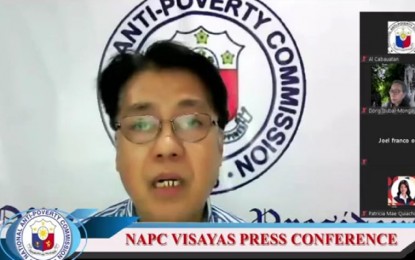
RESPONDING TO POVERTY. National Anti-Poverty Commission (NAPC) Secretary Noel Felongco answers queries during a virtual press conference on Friday (Feb. 5, 2021). He is optimistic that the Duterte administration can achieve its target of reducing poverty incidence in the country down to 14 percent in 2022. (PNA photo screenshot from NAPC FB live)
ILOILO CITY – The National Anti-Poverty Commission (NAPC) has remained optimistic that the target to reduce the country’s poverty incidence to 14 percent in 2022 can be achieved.
Secretary Noel Felongco, in a virtual press conference in time for the NAPC Visayas General Assembly on Planning on Friday, said the health pandemic “has greatly aggravated poverty in the country”.
“We know the effect really of the pandemic. It really caused the economy to shrink drastically affecting the poor,” he said.
The limited movement of their personnel due to lockdown produced minimal accomplishments for the commission.
"Before Covid the poverty incidence in the country is 16.6 percent. Meaning there is a decline of the poverty incidence from 2015 to 2018. Within three years' time, there was a 6.7 decline of the poverty incidence. Yung 2015 poverty incidence kasi is 23.3 so pagdating ng 2018 naging 16. 6 na lamang (The 2015 poverty incidence is 23.3 so in 2018 it dropped to 16.6 percent)," Felongco said.
The decline is equivalent to 5.9 million Filipinos able to rise from poverty and is short of 100,000 to reach the six million target of the Duterte administration, he added.
However, Felongco believes the target was already achieved in 2019 but the incidence of poverty has increased anew when the lockdown was implemented last year.
Felongco said that there was an assessment by the National Economic and Development Authority (NEDA) that the poverty rate could have increased by six to eight percent from 16.6.
Nonetheless, he is hopeful that once the Covid-19 vaccines are available, they can already resume their activities with their target clients from the 14 basic sectors: Artisanal Fisherfolk, Farmers and Landless Rural Workers, Urban Poor, Indigenous Peoples, Formal Labor and Migrant Workers, Workers in the Informal Sector, Women, Children, Youth and Students, Senior Citizens, Persons with Disabilities, Victims of Disasters and Calamities, Non-Government Organizations, and Cooperatives.
Already, NAPC has lined up activities to include among others the roll-out of household monitoring survey in target priority areas in 400 cities and municipalities, and 4,000 barangays nationwide, accomplish the plan to organize one million Kasambayanihan volunteers, complete the village eco-governance development framework in seven Pagcor-NAPC prototype projects, and roll out the implementation of the national poverty reduction plan.
The Kasambayanihan volunteers will serve as “grassroots stewards for poverty monitoring,” he said. In 2019, some 115, 563 volunteers were recruited and 9, 028 in 2020.
Felongco added that they will continue to enter into an agreement with target local government units for the implementation of the Sambayanihan Serbisyong Sambayanan, NAPC’s five-year strategic framework development plan to respond to issues on poverty.
“Through this memorandum of agreement, we are making the LGU our partners in our advocacy and fight against poverty, hunger oppression. We want to assist our basic sectors in getting their share in governance,” he added. (PNA)
